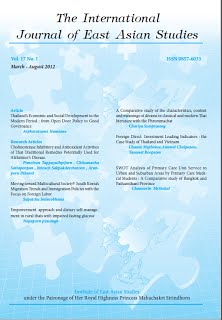Cholinesterase Inhibitory and Antioxidant Activities of Thai Traditional Remedies Potentially Used for Alzheimer’s Disease
Keywords:
Cholinesterase inhibitor, trikatuk remedyAbstract
Background: At present, cholinesterase inhibition and neuronal protection from oxidative
stress are well-known mechanisms that widely used for the treatment of Alzheimer’s disease (AD) (1,2). According to Thai traditional medicine, brain hypo-function, which has similar symptoms to that of AD, was due to declining in wind-element, blood circulation and neurological system. Trikatuk is herbal remedy, strongly increases wind-element, had been used as nootropic remedy for body balance in rainy season. It’s composed of 3 plants: Zingiber off icinale rhizomes (Zo), Piper nigrum fruits (Pn) and Piper retrofractum fruits (Pr) in either ratio of 1:1:1(Tk1), 3:2:1(Tk2),1:3:2(Tk3) or 2:1:3(Tk4).
Aims: This study focused on acetylcholinesterase (AChE) and human butyrylcholinesterase
(BuChE) inhibitory activities by the method of Elman (3, 4) and antioxidant activity by DPPH method(5) of the 4 remedies and ingredients.
Methods: Sixty grams of each plants and recipes were extracted by 95 %ethanol (250 ml x 3), then evaporated under reduced pressure and dried in vacuum-dry at 45 ํC for 24 hour.
Piperine and 6-gingerol of each extracts were also determined by HPLC.
Results: The results showed that the ethanolic extract of the 4 remedies at dose of 0.1 mg/ml had BuChE inhibitory effect more than 70%. The IC50 of AChE inhibitory activity of Zo, Pn, Pr, Tk1, Tk2, Tk3, Tk4, galantamine were >300, 25.46, 51.60, 45.6, 51.97, 41.19, 42.93, 0.1 μg/ml and that of BuChE were 60.82, 42.94, 34.58, 28.74, 25.39, 33.01, 33.28, 0.37 μg/ml respectively. All Trikatuk remedies exhibited higher BuChE inhibitory activity than that of AChE. The Tk1 and Tk2 exhibited higher BuChE inhibitory activity than single herb. The antioxidant activity of Zo and Tk2 were 16.59 and 48.80 μg/ml which was higher activity than the others. The percentage of piperine and 6-gingerol in Tk2 extract (w/w) were 18.57 ± 0.22 and 1.05 ± 0.01 mg/g.
Conclusion: The combined recipes had synergistic effect on BuChE inhibitory activity more than single herb. In addition, the Tk2 might protect neuronal cell from oxidative stress toxicity due to its antioxidant effect. These results revealed that Tk2 was the potential use for AD treatment.



